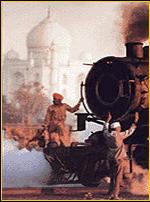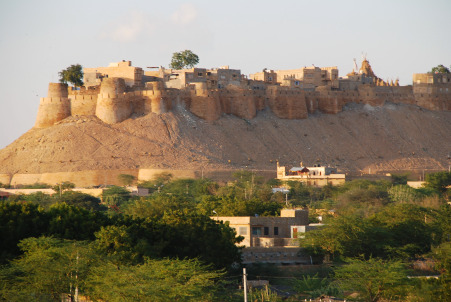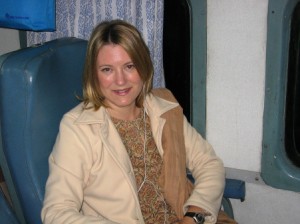I love taking the train in India. It’s a great way to see the country, meet people and generally slow down your trip. Indian Railways is the world’s largest employer and the train system is massive and complex. You can book online on the IRTCT site and find great tips on Figuring out India Rail Travel on the wonderful The Planet D site.
I have many memories of watching India’s sun-baked landscape slide by, but here are two of my favourite train ride stories.
Long day’s journey
New Delhi Railway Station to Jaisalmer
My first clue was the difficulty I had in finding my bogey. Normally, India’s antiquated, seemingly chaotic train system always proves to have a kind of magical order, but this time I rushed up and down the platform looking for my car as none of them were marked. Finally, a fat, satisfied conductor ambled along and began slowing applying the dot-matrix printed sheets listing the reservations to each car. Once I found my car, and bunk, I didn’t feel much better.
India’s trains – like so many things in Indian society – are hierarchical. The Shatabdi’s and Rajdhani‘s are the best: the trains are new-ish, clean and they run on time. They usually ply the routes between India’s major cities – Delhi, Mumbai, Varanasi.
The train I was on was going to Jaisalmer, a far-flung destination in the middle of the Thar Desert, on the edge of India. The train was old, not clean and absolutely crammed full of people and other non-paying guests. Over the course of the 21 hours I spent on that train, I saw about five cockroaches (and stopped counting, because the last two were running along the wall near my face as I was falling asleep) and two large mice. Or small rats. Not sure.
My bunkmates were a family of Spanish women and we made the best of the situation by having a party. Luckily for me, they shared their food with me as I had only two oranges and a bag of almonds to last almost 24 hours.
It was a long journey, and maddening, as we were often stopped waiting for other trains to pass. Finally we got to Jaisalmer and I lunged off the train into the glare of the noonday sun. I was struck by the colours of this far-flung Rajasthani town – splashes of neon pink and orange fabric against a backdrop of pale red earth, golden sandstone and iridescent blue sky – and I felt immediately refreshed by the sunlight and spaciousness.
And when I saw Jaislamer’s impossibly romantic fairy-tale fort rising above the desert, I was in awe. Here was a scene out of the 1,001 Arabian Nights that I idolized as a child. Here was the real-life version of my bedroom walls, which I had painted with exotic, Oriental scenes of genies coming out of bottles, turret-topped palaces and stone fortress-like cityscapes. At once, the arduous train journey melted in the magical heat of the Jaisalmer sun.
Unlikely heroes
New Delhi Railway Station to Haridwar
I arrived at NDLS in the blue light of early morning and began the usual round of haggling to engage a porter. “Neh, neh, there is no way I am paying 200 rupees, I live in Delhi.” One porter seemed unusually keen and genuine, plus he had a killer smile. I uncharacteristically agreed to 100 rupees, more than double the amount a local would pay. We made our way through the dampness and squalor to track 16 and I gave my porter my e-ticket. He discovered that I had only a waiting list ticket. I thought my seat was number 48; in fact, I was 48 on the waiting list and did not stand a chance of getting a seat.
It was a Friday morning and I was trying to board a train to Haridwar, the centre of the Kumbh Mela – the largest spiritual gathering on earth. This train, and all the others leaving for Haridwar for weeks in every direction, had been sold out for months. Nevertheless, my porter did not give up on me. He rushed to find the first-class conductor, and when he didn’t prove helpful, he rushed to find the second-class conductor.
The train was leaving in six minutes and I stood on the platform and poured my appeal for a seat on this man, who had a kindly face. The conductor said, “You can have my seat.” And he told me the number and with only three minutes to spare directed the porter and I to a second-class bogey. The porter genuinely shared my elation, and, I imagine, felt some job satisfaction as he stowed my bag on the overhead rack. I pressed 200 rupees in his hand. “Thank you – you deserve this!” I said, and he flashed his killer smile at me.
Later, when the seat beside me became available, the conductor sat down to chat and told me all about his hiking adventures in the region north of Haridwar and Rishikesh (the Char Dham pilgrimage routes). He was a very friendly and informative person and I took a lot of notes as I hope to do some of these hikes one day.
So, in typical Indian fashion, a so-called problem turned into an opportunity for friendly contact and adventure.

Mariellen Ward is a freelance travel writer whose personal style is informed by a background in journalism, a dedication to yoga and a passion for sharing the beauty of India’s culture and wisdom with the world. She has traveled for about a year altogether in India and publishes an India travel blog, Breathedreamgo.com. Mariellen also writes for magazines and newspapers.











